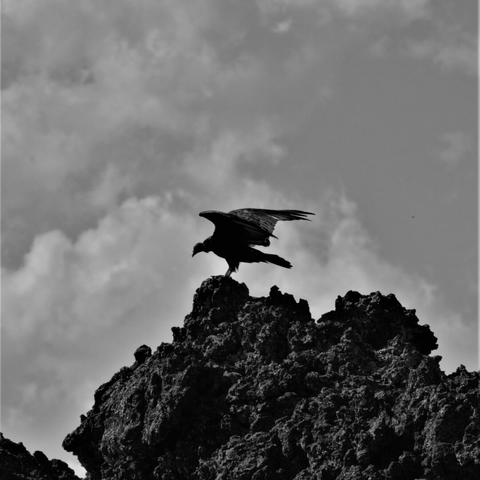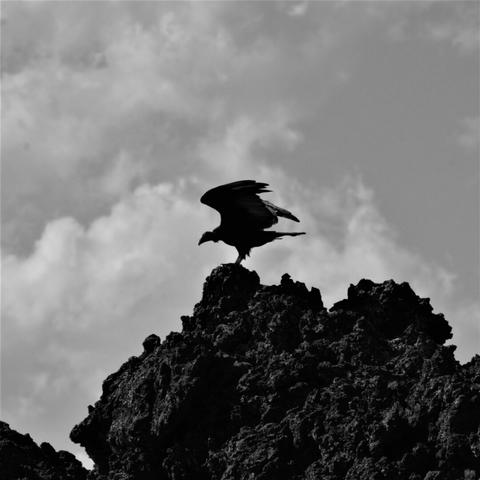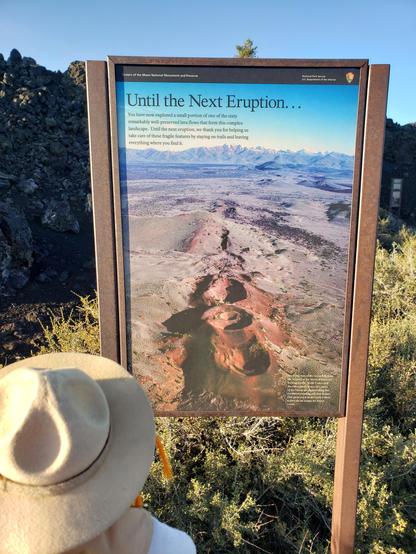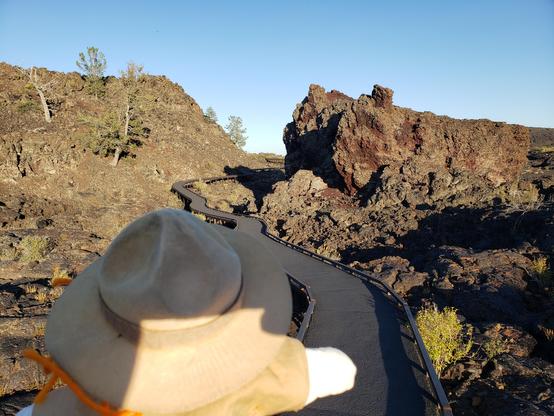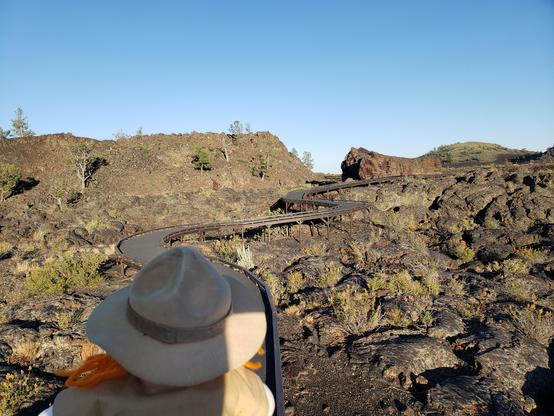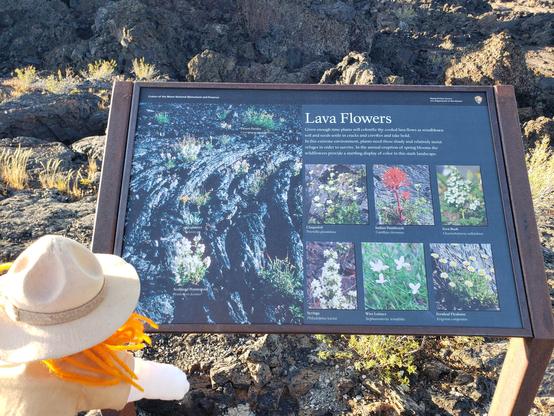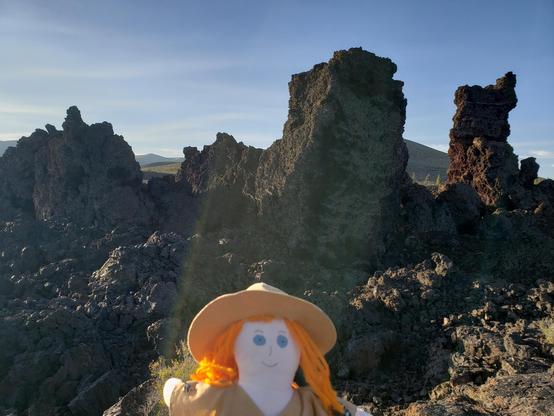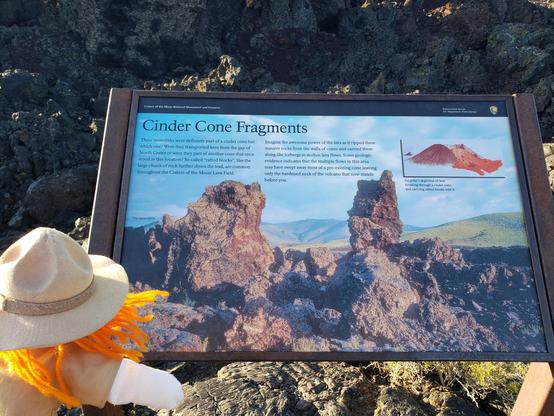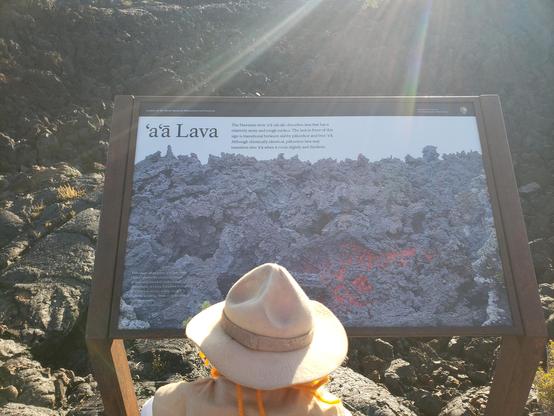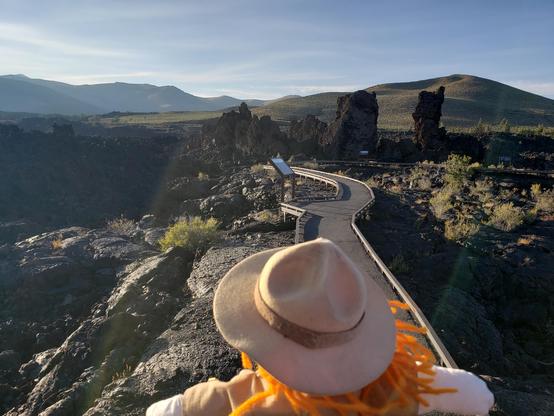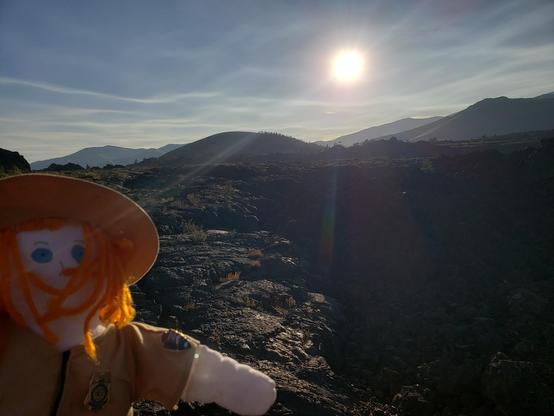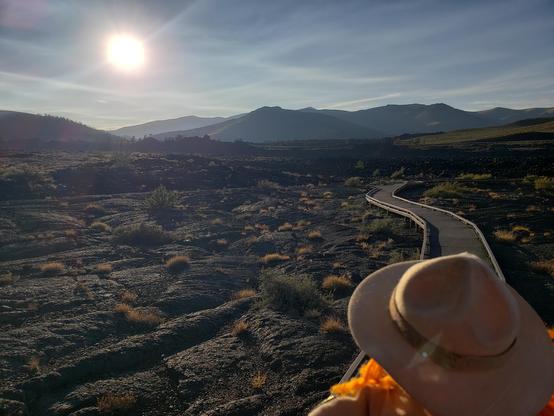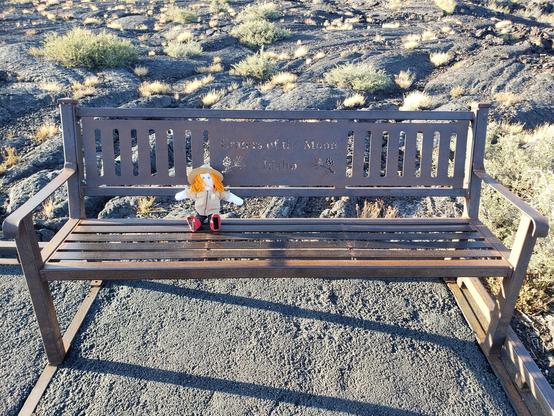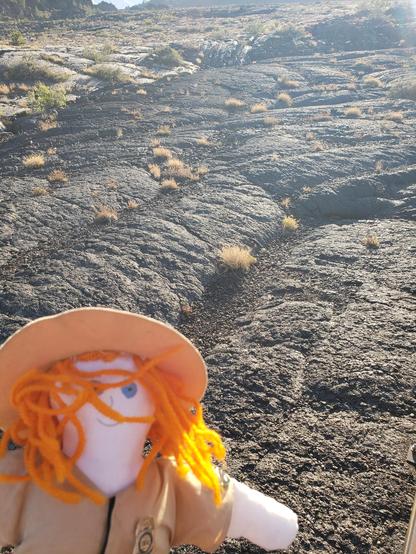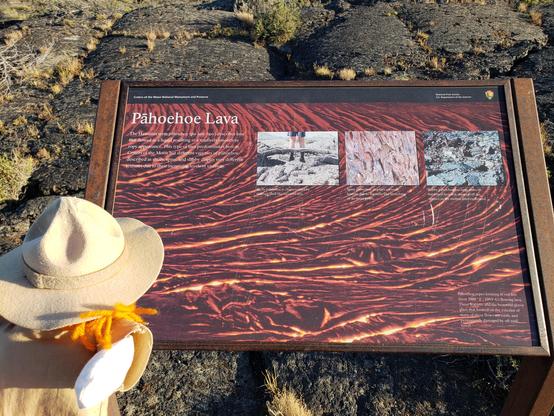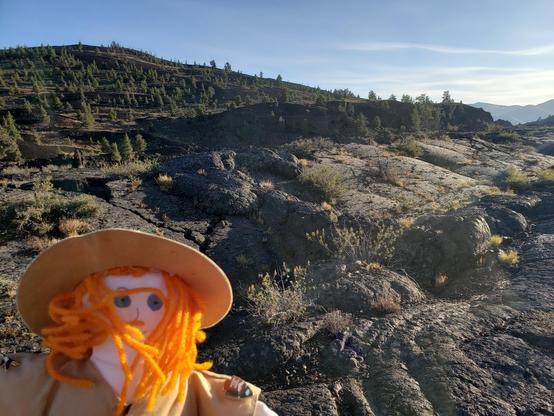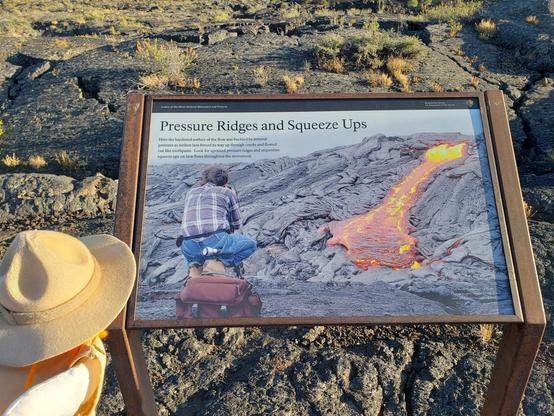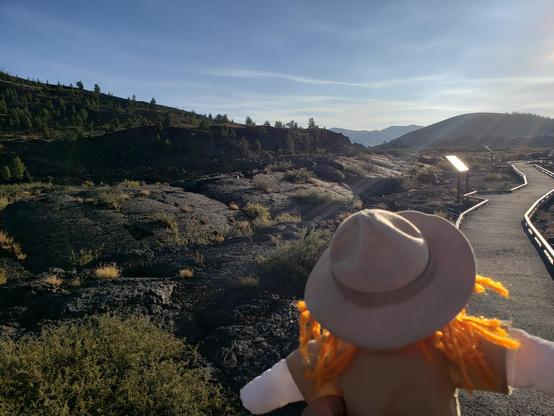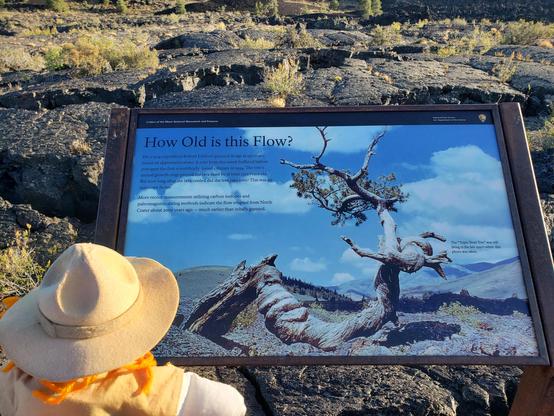#CratersOfTheMoon
#nationalmonument #idaho #cratersofthemoon #birds #vulture #audobonsociety #flight #blackandwhitephotography
Ranger Sarah finished the North Crater Flow Trail and reads the last sign along the trail.
— at Craters of the Moon NPS.
#adventuresofrangersarah #Idaho #outdooradventures #cratersofthemoon #hike #hiking #hikingadventures #volcano #LAVA #geology
Ranger Sarah nears the end of the trail. Some of the lava is red where the blue lava has been broken and removed. This red coloration occurs because basaltic lava rock is high in iron. Metals such as iron rust when they are in contact with oxygen.
— at Craters of the Moon NPS.
#adventuresofrangersarah #Idaho #outdooradventures #cratersofthemoon #hike #hiking #hikingadventures #volcano #LAVA #geology
Ranger Sarah hikes through lava known as Blue Dragon Lava. The blue color comes from a thin outer layer of lava that contains titanium magnetite crystals. These abundant crystals reflect the intense blue light.
— at Craters of the Moon NPS.
#adventuresofrangersarah #Idaho #outdooradventures #cratersofthemoon #hike #hiking #hikingadventures #volcano #LAVA #geology
Ranger Sarah learns about wildflowers that grow in the lava flows.
— at Craters of the Moon NPS.
#adventuresofrangersarah #Idaho #outdooradventures #cratersofthemoon #hike #hiking #hikingadventures #volcano #LAVA #geology
Ranger Sarah looks at the Rafted blocks, or monoliths that came from an unknown cinder cone. Although geologists can't be certain, they now believe that as many as four separate flows came from a vent at or near North Crater.
— at Craters of the Moon NPS.
#adventuresofrangersarah #Idaho #outdooradventures #cratersofthemoon #hike #hiking #hikingadventures #volcano #LAVA #geology
Ranger Sarah learns about Cinder Cone Fragments. Rafted blocks, or monoliths, are sections of a broken crater wall that have been carried along on top of an a'a lava flow. Only a'a flows are thick enough to "float" the blocks to their new locations.
— at Craters of the Moon NPS.
#adventuresofrangersarah #Idaho #outdooradventures #cratersofthemoon #hike #hiking #hikingadventures #volcano #LAVA #geology
Ranger Sarah with the rough a'a lava. A'a flows have a rough, jagged surface and are extremely sharp.
— at Craters of the Moon NPS.
#adventuresofrangersarah #Idaho #outdooradventures #cratersofthemoon #hike #hiking #hikingadventures #volcano #LAVA #geology
Ranger Sarah learns about a'a lava. In Hawaiian, a'a means "hard on the feet." Most lava flows emerge as pahoehoe and somewhere down the slope change into a'a as the lava cools, loses much of its gas, and becomes thicker. As the flow cools, it begins to slow down, moving as a mass of broken rubble.
— at Craters of the Moon NPS.
#adventuresofrangersarah #Idaho #outdooradventures #cratersofthemoon #hike #hiking #hikingadventures #volcano #LAVA #geology
As Ranger Sarah hikes the North Crater Flow Trail she sees a change in the lava as it changes from Pahoehoe Lava to A'a Lava.
— at Craters of the Moon NPS.
#adventuresofrangersarah #Idaho #outdooradventures #cratersofthemoon #hike #hiking #hikingadventures #volcano #LAVA #geology
Ranger Sarah looks out at the vast lava field. Pahoehoe is the most common type of lava flow found at Craters of the Moon.
— at Craters of the Moon NPS.
#adventuresofrangersarah #rangersarah #Idaho #outdooradventures #cratersofthemoon #hike #hiking #hikingadventures #volcano #LAVA #geology
Ranger Sarah continues hiking through the Pahoehoe lava flow. he hot, fast-moving lava beneath pulls, pushes, and twists this cooler top layer into the weird ropes and coils. These ropes and coils can give you a hint to the direction the lava flowed.
— at Craters of the Moon NPS.
#adventuresofrangersarah #rangersarah #Idaho #outdooradventures #cratersofthemoon #hike #hiking #hikingadventures #volcano #LAVA #geology
Ranger Sarah takes a break on a cool bench. Pahoehoe flows are often seen flowing like glowing orange rivers. As the surface of a pahoehoe flow cools it forms a sort of "skin."
— at Craters of the Moon NPS.
#adventuresofrangersarah #rangersarah #Idaho #outdooradventures #cratersofthemoon #hike #hiking #hikingadventures #volcano #LAVA #geology
Ranger Sarah with some of the smooth Pahoehoe Lava. Much of the pahoehoe at Craters of the Moon was very viscous or thick and was very close to being aa. Even in large channels this thick lava was probably only flowing at 3-6 miles per hour.
— at Craters of the Moon NPS.
#adventuresofrangersarah #rangersarah #Idaho #outdooradventures #cratersofthemoon #hike #hiking #hikingadventures #volcano #LAVA #geology
Ranger Sarah learns about Pahoehoe Lava. Pahoehoe is a smooth lava that often forms ropes and coils. Pahoehoe means "ropy" in Hawaiian. Pahoehoe flows are very hot, around 2,000 degrees Fahrenheit, and have been clocked flowing at speeds of more than 30 miles per hour.
— at Craters of the Moon NPS.
#adventuresofrangersarah #rangersarah #Idaho #outdooradventures #cratersofthemoon #hike #hiking #hikingadventures #volcano #LAVA #geology
Ranger Sarah looks at a Presure Ridge. Pressure ridges are a common feature of pahoehoe flows.
— at Craters of the Moon NPS.
#adventuresofrangersarah #rangersarah #Idaho #outdooradventures #cratersofthemoon #hike #hiking #hikingadventures #volcano #LAVA #geology
Ranger Sarah learns about Pressure Ridges. They form as the flow's crust is pushed upwards by the pressure of the moving lava beneath. The arched crust generally cracks open, and may allow molten lava to "squeeze up" to the surface like toothpaste out of a tube.
— at Craters of the Moon NPS.
#adventuresofrangersarah #rangersarah #Idaho #outdooradventures #cratersofthemoon #hike #hiking #hikingadventures #volcano #LAVA #geology
Ranger Sarah hikes through the Lava Field. As the lava cools, tiny magnetic crystals align themselves in the direction of the earth's current magnetic field. Scientist can use this information to date the lava fields.
— at Craters of the Moon NPS.
#adventuresofrangersarah #rangersarah #Idaho #outdooradventures #cratersofthemoon #hike #hiking #hikingadventures #volcano #LAVA #geology
Ranger Sarah with the 1350 year old triple twist tree. The lava field it grew up in is 2000 years old.
— at Craters of the Moon NPS.
#adventuresofrangersarah #rangersarah #Idaho #outdooradventures #cratersofthemoon #hike #hiking #hikingadventures #volcano #LAVA #geology
Ranger Sarah learns that the triple twisted had a core sample taken from it which showed it to be at least 1,350 years.
— at Craters of the Moon NPS.
#adventuresofrangersarah #rangersarah #Idaho #outdooradventures #cratersofthemoon #hike #hiking #hikingadventures #volcano #LAVA #geology
